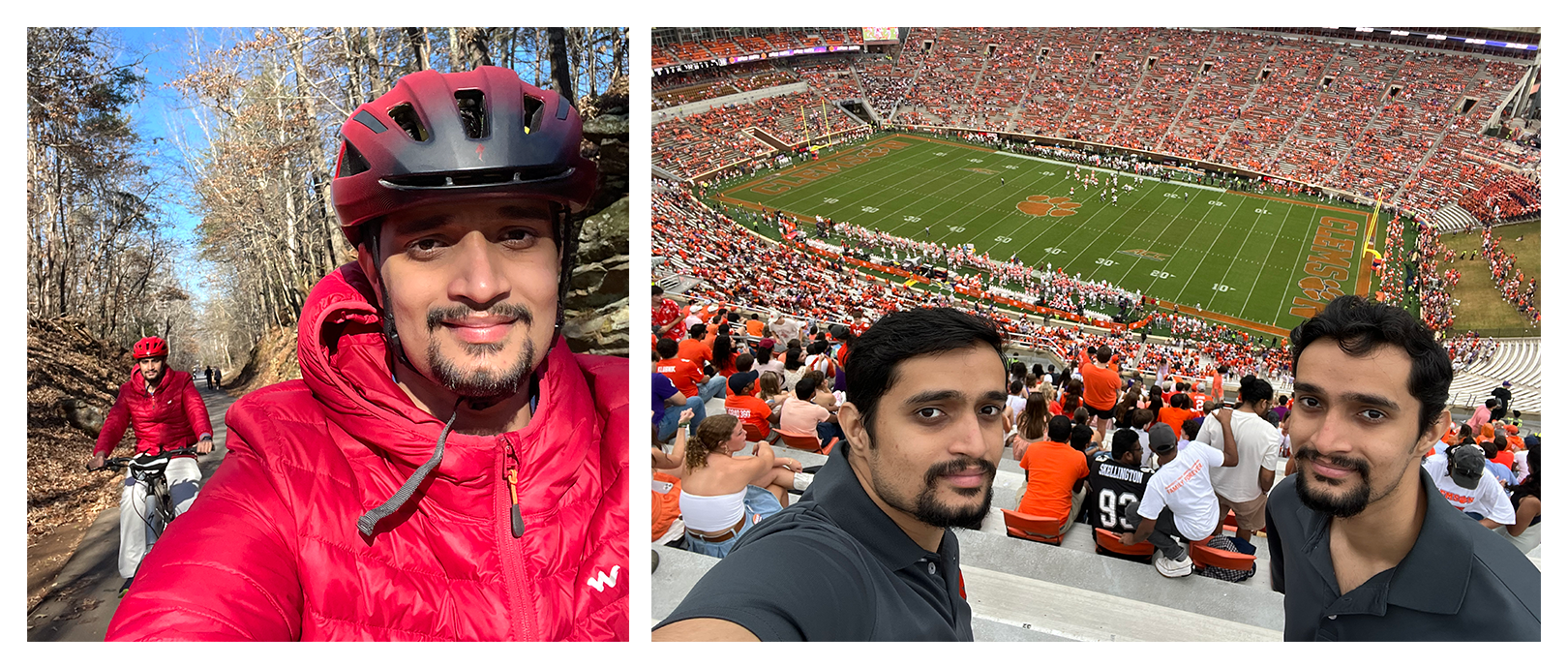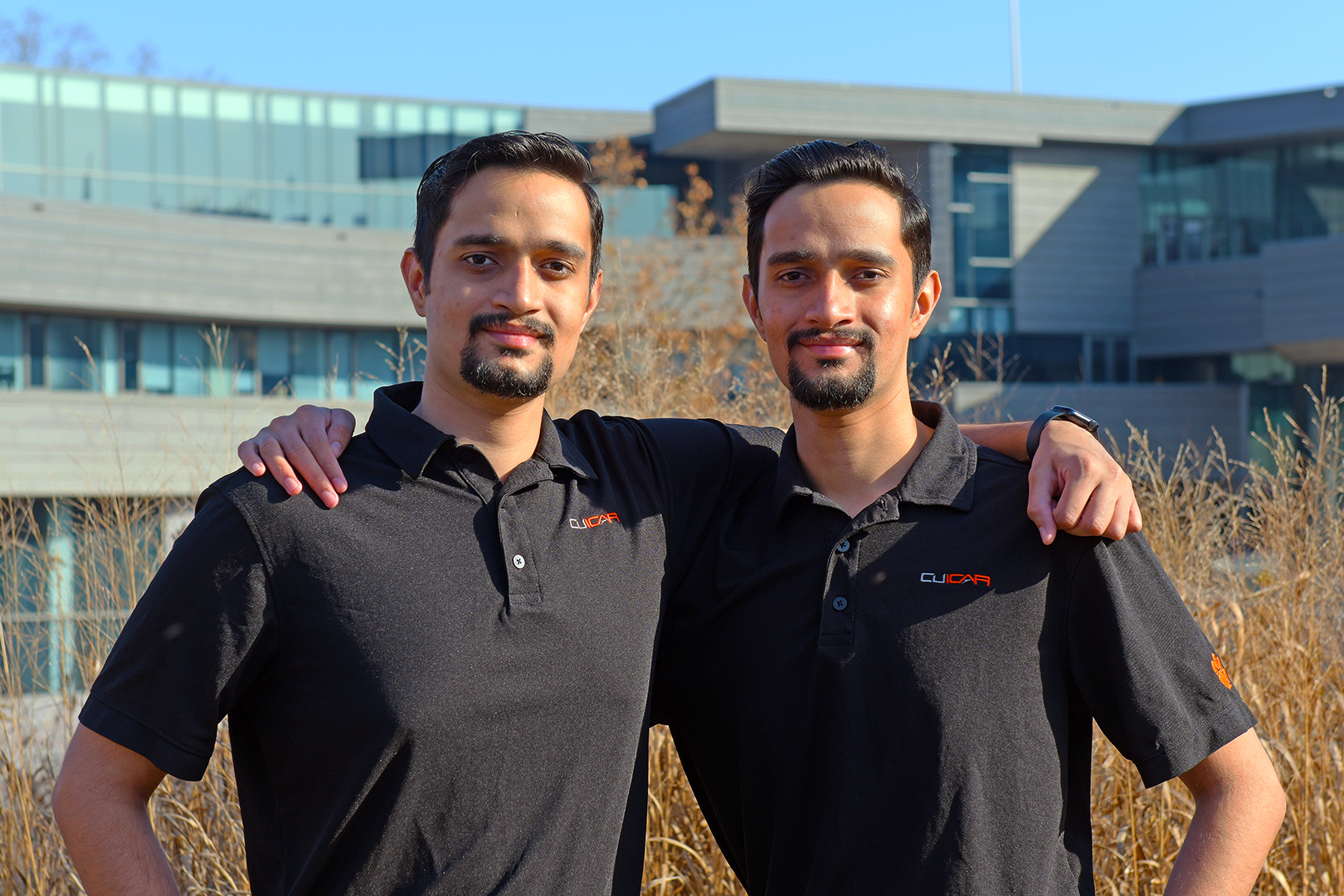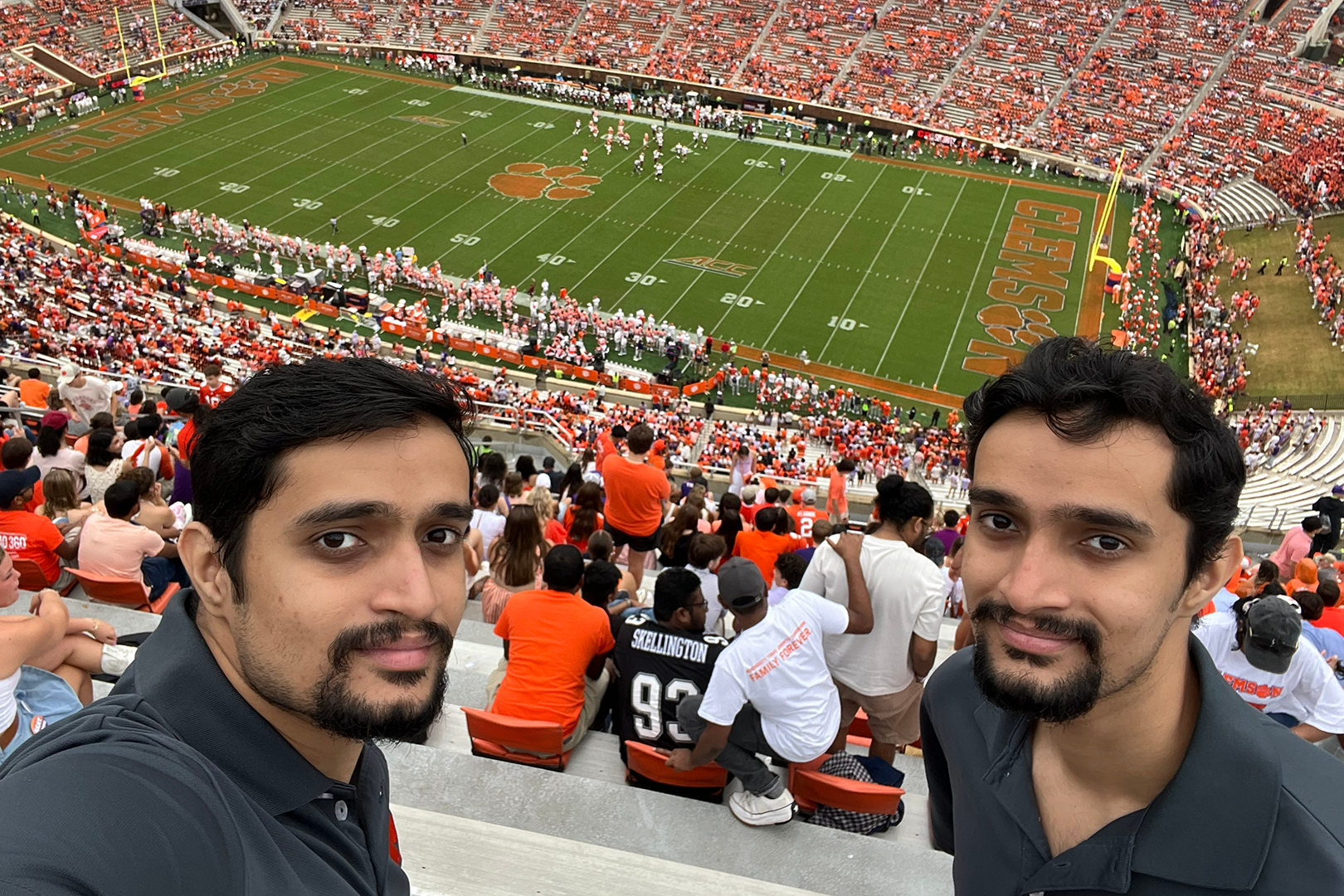Partner Profile:
Chinmay & Tanmay Samak,
Clemson University Automotive Engineering
November 24, 2025
Partner Profile:
Chinmay & Tanmay Samak,
Clemson University Automotive Engineering
November 24, 2025
A digital twin uses real-world data to power a virtual counterpart—an idea reshaping modern engineering. For Chinmay and Tanmay Samak, mirrored counterparts is not only the focus of their research at the Clemson University International Center for Automotive Research (CU-ICAR), it’s also their daily experience as twins who are identical in virtually every way.
Building Blocks
Natives of Pune, India, Chinmay and Tanmay have always known what they have in common truly makes them unique. “It’s always been fun to have a twin, especially one that resonates with you,” said Chinmay. “Twins generally get compared constantly so they choose a mechanism for growing apart or at least a way to differentiate themselves, but that hasn’t been our experience.”
From favorite foods to hobbies, and even their favorite color, the Samak twins have no answer for the common question of how to differentiate them. “We’ve been together since day one and hope to keep it that way,” said Tanmay with a smile.
At a young age their shared interests included activities like cycling, hiking and tinkering in the field of robotics. What began in 8th grade as building line-following and obstacle-avoidance robots grew into research publications and consecutive first place finishes in NASA’s space settlement design competition. By the time they reached their undergraduate studies, they found another shared fascination: autonomous ground vehicles—a passion that would eventually bring them across the world to Greenville, South Carolina.
Simulation to Reality
When considering graduate programs, the brothers developed their own unique criteria to complement university rankings and notoriety.
- A strong academic program in automotive engineering, autonomy, and robotics
- A direct path into a fully funded PhD program
- Access to full-scale test vehicles and state-of-the-art equipment
- An opportunity to work together, in the same lab, under the same advisor
Despite having never visited, they chose Clemson University, and specifically the Automotive Engineering program located at CU-ICAR. Three and a half years later, they are nearing the completion of their PhDs, with both focused on advancing digital twin technology. Working in the Automation, Robotics and Mechatronics (ARM) Lab under Dr. Venkat Krovi, they are helping to close the loop between real-world vehicle behavior and high-precision simulation. Tanmay specializes in translating real-world data into accurate virtual models. Chinmay’s work mirrors this from the opposite direction, ensuring simulation results can be transferred reliably to physical vehicles.
Looking back on their decision, Chinmay shared what he’d tell their 2022 selves: “In a simple statement, what you are dreaming of is about to come true.”

Unexpected Variables
Due to COVID-19, the twins arrived in Greenville knowing Dr. Krovi and CU-ICAR only through digital imagery, articles and virtual interviews. Their real-world experience far exceeded expectations.
Being welcomed with hands-on access to the Open Connected and Automated Vehicle (OpenCAV) during their first weeks on campus, months earlier than expected, made it clear they had found the mentor they hoped for. “Dr. Krovi is the ideal advisor, especially for us,” said Chinmay. “He’s provided the technical and academic direction for areas where he knows we need to learn and also given us the freedom to explore on our own and approach him when we need guidance.”
The positive surprises extended out of the lab as they began to explore the CU-ICAR campus and the surrounding Greenville community. “CU-ICAR has all the right people on campus,” noted Tanmay. “You have students, professors, and industry professionals, and they’re all headed towards the same objectives. No matter who you’re working with, you can’t go wrong.”
Off campus, Greenville quickly became their second home, one they describe as the perfect balance of modern and tranquil. They fell in love with the mild weather, vibrant downtown, access to nature, and as cyclists, the city’s 28-mile greenway known as the Swamp Rabbit Trail.

The Path Ahead
Within the next year, Chinmay and Tanmay will add “Clemson graduate” to their list of accomplishments. From there, they hope to stay connected to academia while also joining industry through startup ventures. They plan to continue growing their online presence as the Tinker Twins and expand AutoDRIVE, the digital twin ecosystem they created together.
While the exact path ahead is still unfolding, one thing remains certain:
“Whatever it is, most importantly, we’ll do it together.”

A digital twin uses real-world data to power a virtual counterpart—an idea reshaping modern engineering. For Chinmay and Tanmay Samak, mirrored counterparts is not only the focus of their research at the Clemson University International Center for Automotive Research (CU-ICAR), it’s also their daily experience as twins who are identical in virtually every way.
Building Blocks
Natives of Pune, India, Chinmay and Tanmay have always known what they have in common truly makes them unique. “It’s always been fun to have a twin, especially one that resonates with you,” said Chinmay. “Twins generally get compared constantly so they choose a mechanism for growing apart or at least a way to differentiate themselves, but that hasn’t been the case for us.”
From favorite foods to hobbies, and even their favorite color, the Samak twins have no answer for the common question of how to differentiate them. “We’ve been together since day one and hope to keep it that way,” said Tanmay with a smile.
At a young age their shared interests included activities like swimming, cycling, hiking and tinkering in the field of robotics. What began in 8th grade as building line-following and obstacle-avoidance robots grew into research publications and consecutive first place finishes in NASA’s space settlement design competition. By the time they reached their undergraduate studies, they found another shared fascination: autonomous ground vehicles—a passion that would eventually bring them across the world to Greenville, South Carolina.
Simulation to Reality
When considering graduate programs, the brothers developed their own unique criteria to complement university rankings and notoriety.
- A strong academic program in automotive engineering, autonomy, and robotics
- A direct path into a fully funded PhD program
- Access to full-scale test vehicles and state of the art equipment
- An opportunity to work together, in the same lab, under the same advisor
Despite having never visited, they chose Clemson University, and specifically the Automotive Engineering program located at CU-ICAR. Three and a half years later, they are nearing the completion of their PhDs, with both focused on advancing digital twin technology. Working in the Automation, Robotics and Mechatronics (ARM) Lab under Dr. Venkat Krovi, they are helping to close the loop between real-world vehicle behavior and high-precision simulation. Tanmay specializes in translating real-world data into accurate virtual models. Chinmay’s work mirrors this from the opposite direction, ensuring simulation results can be transferred reliably to physical vehicles.
Looking back on their decision, Chinmay shared what he’d tell their 2022 selves: “In a simple statement, what you are dreaming of is about to come true.”

Unexpected Variables
Due to COVID-19, the twins arrived in Greenville knowing Dr. Krovi and CU-ICAR only through digital imagery, articles and virtual interviews. Their real-world experience far exceeded expectations.
Being welcomed with hands-on access to the Open Connected and Automated Vehicle (OpenCAV) during their first weeks on campus, months earlier than expected, made it clear they had found the mentor they hoped for. “Dr. Krovi is the ideal advisor, especially for us,” said Chinmay. “He’s provided the technical and academic direction for areas where he knows we need to learn and also given us the freedom to explore on our own and approach him when we need guidance.”
The positive surprises extended out of the lab as they began to explore the CU-ICAR campus and the surrounding Greenville community. “CU-ICAR has all the right people on campus,” noted Tanmay. “You have students, professors, and industry professionals, and they’re all headed towards the same objectives. No matter who you’re working with, you can’t go wrong.”
Off campus, Greenville quickly became their second home, one they describe as the perfect balance of modern and tranquil. They fell in love with the mild weather, vibrant downtown, access to nature, and as cyclists, the city’s 28-mile greenway known as the Swamp Rabbit Trail.

The Path Ahead
Within the next year, Chinmay and Tanmay will add “Clemson graduate” to their list of accomplishments. From there, they hope to stay connected to academia while also joining industry through startup ventures. They plan to continue growing their online presence as the Tinker Twins and expand AutoDRIVE, the digital twin ecosystem they created together.
While the exact path ahead is still unfolding, one thing remains certain:
“Whatever it is, most importantly, we’ll do it together.”

A digital twin uses real-world data to power a virtual counterpart—an idea reshaping modern engineering. For Chinmay and Tanmay Samak, mirrored counterparts is not only the focus of their research at the Clemson University International Center for Automotive Research (CU-ICAR), it’s also their daily experience as twins who are identical in virtually every way.
Building Blocks
Natives of Pune, India, Chinmay and Tanmay have always known what they have in common truly makes them unique. “It’s always been fun to have a twin, especially one that resonates with you,” said Chinmay. “Twins generally get compared constantly so they choose a mechanism for growing apart or at least a way to differentiate themselves, but that hasn’t been the case for us.”
From favorite foods to hobbies, and even their favorite color, the Samak twins have no answer for the common question of how to differentiate them. “We’ve been together since day one and hope to keep it that way,” said Tanmay with a smile.
At a young age their shared interests included activities like swimming, cycling, hiking and tinkering in the field of robotics. What began in 8th grade as building line-following and obstacle-avoidance robots grew into research publications and consecutive first place finishes in NASA’s space settlement design competition. By the time they reached their undergraduate studies, they found another shared fascination: autonomous ground vehicles—a passion that would eventually bring them across the world to Greenville, South Carolina.
Simulation to Reality
When considering graduate programs, the brothers developed their own unique criteria to complement university rankings and notoriety.
- A strong academic program in automotive engineering, autonomy, and robotics
- A direct path into a fully funded PhD program
- Access to full-scale test vehicles and state-of-the-art equipment
- An opportunity to work together, in the same lab, under the same advisor
Despite having never visited, they chose Clemson University, and specifically the Automotive Engineering program located at CU-ICAR. Three and a half years later, they are nearing the completion of their PhDs, with both focused on advancing digital twin technology. Working in the Automation, Robotics and Mechatronics (ARM) Lab under Dr. Venkat Krovi, they are helping to close the loop between real-world vehicle behavior and high-precision simulation. Tanmay specializes in translating real-world data into accurate virtual models. Chinmay’s work mirrors this from the opposite direction, ensuring simulation results can be transferred reliably to physical vehicles.
Looking back on their decision, Chinmay shared what he’d tell their 2022 selves: “In a simple statement, what you are dreaming of is about to come true.”

Unexpected Variables
Due to COVID-19, the twins arrived in Greenville knowing Dr. Krovi and CU-ICAR only through digital imagery, articles and virtual interviews. Their real-world experience far exceeded expectations.
Being welcomed with hands-on access to the Open Connected and Automated Vehicle (OpenCAV) during their first weeks on campus, months earlier than expected, made it clear they had found the mentor they hoped for. “Dr. Krovi is the ideal advisor, especially for us,” said Chinmay. “He’s provided the technical and academic direction for areas where he knows we need to learn and also given us the freedom to explore on our own and approach him when we need guidance.”
The positive surprises extended out of the lab as they began to explore the CU-ICAR campus and the surrounding Greenville community. “CU-ICAR has all the right people on campus,” noted Tanmay. “You have students, professors, and industry professionals, and they’re all headed towards the same objectives. No matter who you’re working with, you can’t go wrong.”
Off campus, Greenville quickly became their second home, one they describe as the perfect balance of modern and tranquil. They fell in love with the mild weather, vibrant downtown, access to nature, and as cyclists, the city’s 28-mile greenway known as the Swamp Rabbit Trail.

The Path Ahead
Within the next year, Chinmay and Tanmay will add “Clemson graduate” to their list of accomplishments. From there, they hope to stay connected to academia while also joining industry through startup ventures. They plan to continue growing their online presence as the Tinker Twins and expand AutoDRIVE, the digital twin ecosystem they created together.
While the exact path ahead is still unfolding, one thing remains certain:
“Whatever it is, most importantly, we’ll do it together.”



